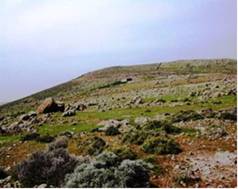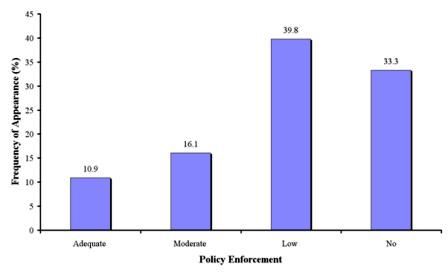Policy enforcement
This indicator is related to the enforcement of the implementation of existing regulations on environmental protection. The policy enforcement indicator is used to assess the degree of application of the specific regulation on environmental protection. For example in a cultivated area some typical management practices for reducing tillage and water erosion is: (i) no tillage or minimum tillage, (ii) tillage of soil in the up-slope direction, (iii) contour farming, (iv) enhancement of vegetation cover. Therefore, protection of the land from soil erosion depends on the effectiveness of the implementation /enforcement of such actions (Fig. 98). The information needed depends on the policy under consideration. For example, in the case of terracing protection policy, a relevant piece of information might be the ratio of protected to existing terraces. In the case of extensive agriculture policy, a relevant piece of information might be the percentage of farms (or farmers) or the percentage of area under extensive agriculture.


Fig. 98. Examples of no enforcement of the implementation of existing regulations on environmental protection from soil erosion in grazing land (left) and fully enforcement for protection of olive grove by building terraces (right)
Four classes of policy enforcement have been distinguished in this project: (a) adequate, >75% of the land is protected; (b) moderate, 25-75% of the land is protected; (c) low, <25% of the land is protected; and (d) no protection of the land. The policy enforcement in each field site was assessed by considering the existing regulations for environmental protection in each study site and estimating the degree in which the regulation is applied by personal judgment.
As Table 15 shows, data for this indicator were collected in 1582 field sites, corresponding to 17 study sites. The analysis of data shows that low policy enforcement of existing regulations for environmental protection is the dominant class in the study field sites, covering 39.8% of the field sites. Such conditions have been described in the all field sites of Boteti Area-Botswana, Santiago Island-Cape Verde, Secano Interior-Chile, Guadalentin Basin Murcia-Spain, and Eskisehir-Turkey sites, and in some cases in the study sites of Mamora Sehoul-Morocco, Gois-Portugal, Cointzio Catchment-Mexico, Zeuss Koutine-Tunisia, Loess Plateau-China, and Crete-Greece. The next important class for this indicator is none regulation on environmental protection is implemented, covering 33.3% of the study field sites. Such field sites have been identified in the all cases of the study field sites of Novij Saratov-Russia, Djanybek-Russia, Rendina Basin Basilicata-Italy, and Mação- Portugal sites, and in some cases in the study sites of Loess Plateau-China, Gois-Portugal, Mamora Sehoul-Morocco, Zeuss Koutine-Tunisia, and Crete-Greece. Moderate policy enforcement has been identified in 16.1% of the study field sites, corresponding to the study sites of Zeuss Koutine-Tunisia, Konya Karapinar plain-Turkey, Cointzio Catchment-Mexico, Gois-Portugal, and Crete-Greece. Finally, adequate policy enforcement has been identified in 10.9% of the study field sites, corresponding to the study sites of Mamora Sehoul-Morocco, Zeuss Koutine-Tunisia, Loess Plateau-China, Gois-Portugal, and Crete-Greece.

Fig. 99. Distribution of degree of policy enforcement of existing regulations for environmental protection defined in the study field sites